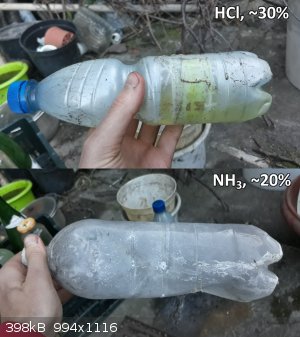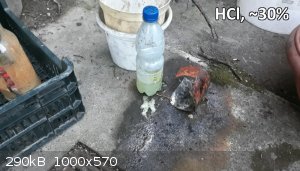vano
National Hazard
   
Posts: 661
Registered: 22-3-2019
Location: Georgia
Member Is Offline
|
|
PET + ammonia. white powder
Hi. Sometimes i store ammonia solution on PET bottle. A few days ago I poured all the ammonia solution into a HDPE bottle. Of course i filtered it.
And I collected this white powder. The particles are very small. What do you think is it a PET powder? or other organic compound(Terephthalic acid or
ammonia salt).
[Edited on 17-1-2021 by vano]
[Edited on 17-1-2021 by vano]
|
|
|
vano
National Hazard
   
Posts: 661
Registered: 22-3-2019
Location: Georgia
Member Is Offline
|
|
I found answer
|
|
|
Mateo_swe
National Hazard
   
Posts: 505
Registered: 24-8-2019
Location: Within EU
Member Is Offline
|
|
I guess you found out that Ammonia should not be stored in PET bottles but i reply if anybody else also need to know.
Check solvent comparability with plastics before storing in different plastic bottles or containers.
Ammonia slowly dissolves certain plastics, like PET.
Some solvents and chemicals store fine in PET bottles but check comparability before using them.
Just google solvent comparability chart and you will find a lot of them.
You can watch this video on YT for some examples of what not to store in PET bottles and some solvents that can be stored in PET.
https://www.youtube.com/watch?v=E9Snse16qkE
|
|
|
symboom
International Hazard
    
Posts: 1143
Registered: 11-11-2010
Location: Wrongplanet
Member Is Offline
Mood: Doing science while it is still legal since 2010
|
|
Oh that's interesting that ammonia attacks some plastics I always thought plastic was much more chemical resistant than that I wonder 8f that can be
exploited in reprocessing plastic.
|
|
|
Boffis
International Hazard
    
Posts: 1836
Registered: 1-5-2011
Member Is Offline
Mood: No Mood
|
|
There's a whole thread on this somewhere on SM that followed from one members observasion that PET bottles disintegrate when used to store ammonia
solution but interesting above the liquid level first. This lead to my own experiments into the preparation terephthalamide by exposing PET to ammonia
fumes. It works but the product is difficult to purify. However by leach with dilute acid and dilute alkali you can remove the half amide bt the
incompletely hydrolyses polymer can't be separated by any means available to me.
Check out the bottom part of this thread and the subsequent pages:
http://www.sciencemadness.org/talk/viewthread.php?tid=63196
|
|
|
Piroz
Harmless

Posts: 19
Registered: 15-12-2020
Location: Poland
Member Is Offline
|
|
Few years ago I stored some chemicals in plastic PET bottles. I found that PET bottles can be permanently destroyed by 30% hydrochloric acid (it turns
into pearl like- colour, become very brittle). With ammonia bottle is thinner and thinner during time and some small holes may occur later. Strong
bases solutions (NaOH, KOH) destroying bottles within a week. However I still have 37% battery acid on the shelf in my garage (about 10 years) and no
changes occur.
 
[Edited on 19-1-2021 by Piroz]
|
|
|
draculic acid69
International Hazard
    
Posts: 1371
Registered: 2-8-2018
Member Is Offline
|
|
Quote: Originally posted by symboom  | | Oh that's interesting that ammonia attacks some plastics I always thought plastic was much more chemical resistant than that I wonder 8f that can be
exploited in reprocessing plastic. |
Yes it can.basically the ammonia is just a strong reactive base hydrolyzing the ester that is pet forming ammonia terepthalate and ethylene glycol I
guess.on paper it's how it should be in reality it could possibly just be a solvent that dissolves pet but I doubt it's just that. I know that pet can
be recycled back to its starting compounds by ester hydrolysis with NaOH. I've left conc. caustic soda (60%) in pet bottles and eventually it just
dissolves the pet at room temperature
|
|
|
vano
National Hazard
   
Posts: 661
Registered: 22-3-2019
Location: Georgia
Member Is Offline
|
|
Quote: Originally posted by Piroz  | Few years ago I stored some chemicals in plastic PET bottles. I found that PET bottles can be permanently destroyed by 30% hydrochloric acid (it turns
into pearl like- colour, become very brittle). With ammonia bottle is thinner and thinner during time and some small holes may occur later. Strong
bases solutions (NaOH, KOH) destroying bottles within a week. However I still have 37% battery acid on the shelf in my garage (about 10 years) and no
changes occur.
[Edited on 19-1-2021 by Piroz] |
My PET was very white. I also stored concentrated hydrochloric acid in a PET bottle, however, the color has not changed
|
|
|
solo
International Hazard
    
Posts: 3967
Registered: 9-12-2002
Location: Estados Unidos de La Republica Mexicana
Member Is Offline
Mood: ....getting old and drowning in a sea of knowledge
|
|
......here is a helpful guide regarding plastics reactivity with a list of solvents, a list which may already be posted someplace....solo
https://www.plasticsintl.com/chemical-resistance-chart
It's better to die on your feet, than live on your knees....Emiliano Zapata.
|
|
|
Fantasma4500
International Hazard
    
Posts: 1677
Registered: 12-12-2012
Location: Dysrope (aka europe)
Member Is Offline
Mood: dangerously practical
|
|
ammonium terephthalate should be interesting in terms of thermal decomposition. theres oftenly interesting byproducts from decomposing ammonium salts.
and that ammonia reacts somewhat readily with PET just makes it more interesting
i believe pyrolysis is used on the sodium salt to try to get something useful out of it, im sure the ammonium salt would be much more interesting to
work with in that regard
|
|
|
draculic acid69
International Hazard
    
Posts: 1371
Registered: 2-8-2018
Member Is Offline
|
|
Quote: Originally posted by Antiswat  | ammonium terephthalate should be interesting in terms of thermal decomposition. theres oftenly interesting byproducts from decomposing ammonium salts.
and that ammonia reacts somewhat readily with PET just makes it more interesting
i believe pyrolysis is used on the sodium salt to try to get something useful out of it, im sure the ammonium salt would be much more interesting to
work with in that regard |
What is the product of the sodium terepthalate thing your talking about.
|
|
|